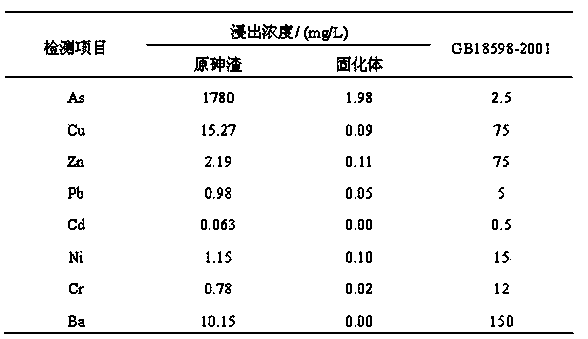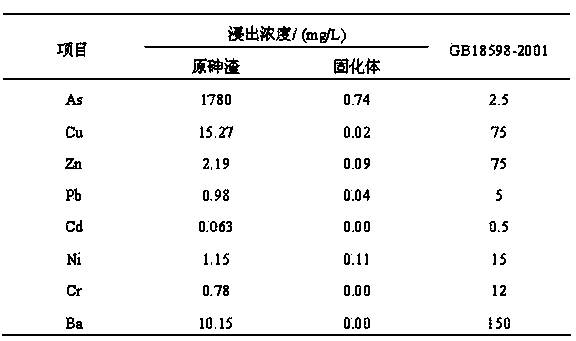Stable curing method of strongly acidic arsenic sulfide waste residues
A solidification method and technology of arsenic sulfide, applied in chemical instruments and methods, solid waste removal, transportation and packaging, etc., can solve the problems of long maintenance time, high treatment cost, unfavorable efficiency, etc., and achieve short maintenance time and high treatment efficiency. The effect of high efficiency and simple operation
- Summary
- Abstract
- Description
- Claims
- Application Information
AI Technical Summary
Problems solved by technology
Method used
Image
Examples
Embodiment 1)
[0024] The strongly acidic arsenic sulfide waste slag treated in this example comes from the sulfuric acid production workshop. According to the "Identification Standard for Hazardous Waste Corrosion Identification" (GB 5085.1-2007), the pH value of the waste leaching solution is 1.2; Based on silver dithiocarbamate spectrophotometry" (GB / T 15555.3-1995), the leaching concentration of arsenic was measured to be 1780mg / L.
[0025] The stable solidification method of the strongly acidic arsenic sulfide waste residue of the present embodiment comprises the following steps:
[0026] ①Weigh 50g of strong acid arsenic sulfide slag to be treated, add 50g of heavy metal sludge with a moisture content of 50% to it, stir for 40 minutes, and the material after stirring is muddy. The mass ratio of strongly acidic arsenic sulfide slag to heavy metal sludge is 1:1.
[0027] The heavy metal sludge is heavy metal-containing sludge produced after wastewater treatment in industries such as met...
Embodiment 2)
[0041] The stable solidification method of the strongly acidic arsenic sulfide waste residue of the present embodiment is the same as embodiment 1 except that:
[0042] In step ①, add 75 g of heavy metal sludge with a moisture content of 85% to 50 g of strongly acidic arsenic sulfide slag, and stir for 20 minutes. The mass ratio of strongly acidic arsenic sulfide slag to heavy metal sludge is 1:1.5.
[0043] Step 2. Add 60 g of calcium hydroxide powder to the slurry material obtained in step 1. After stirring for 20 minutes, all the yellow substances in the slurry material disappear and become slightly black. The mass ratio of strongly acidic arsenic sulfide waste residue to calcium hydroxide powder is 1:-1.2.
[0044] Step 3. Add 25g of yellow sand and 25g of cement to the slightly black material obtained after stirring in step 2.
[0045] According to the "Identification Standards for Hazardous Wastes - Identification of Toxic Substance Content" (GB 5085.6-2007), the detec...
PUM
 Login to View More
Login to View More Abstract
Description
Claims
Application Information
 Login to View More
Login to View More - R&D
- Intellectual Property
- Life Sciences
- Materials
- Tech Scout
- Unparalleled Data Quality
- Higher Quality Content
- 60% Fewer Hallucinations
Browse by: Latest US Patents, China's latest patents, Technical Efficacy Thesaurus, Application Domain, Technology Topic, Popular Technical Reports.
© 2025 PatSnap. All rights reserved.Legal|Privacy policy|Modern Slavery Act Transparency Statement|Sitemap|About US| Contact US: help@patsnap.com


